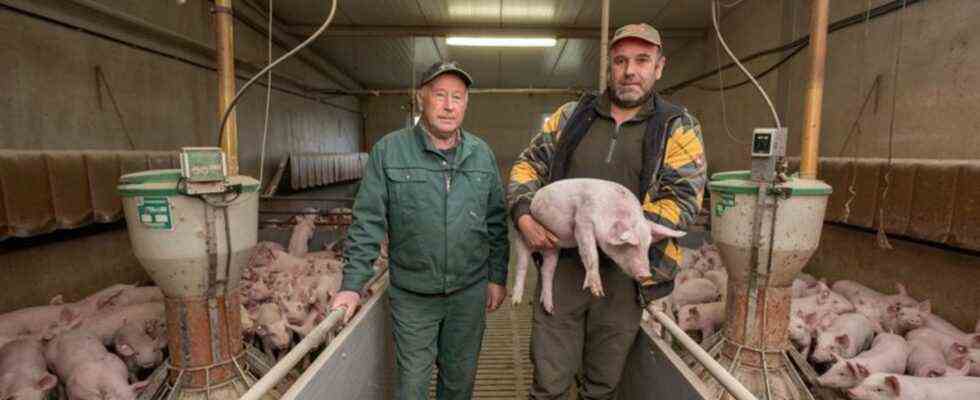After more than 50 years and three generations, the Webers give up their pig breeding. They would like to continue, but they can no longer pay them. They are like countless other farmers.
Soon the two of them will no longer have a pig. At Marco and Udo Weber’s farm in Lissendorf in Rhineland-Palatinate, there is more space in the stable every week.
A few months ago there were 250 breeding sows and 700 fattening pigs here, and 250 piglets were fattened per year. But the two men, third generation pig farmers, are giving up. 20 sows are still pregnant in the barn because Udo Weber had them inseminated again: “They will farrow in December, then it’s time to go.”
Senior boss Karl Weber (80) is pleased that the pig farm will not end until March 2022 because of the piglets, three months later than originally planned. There are tears in his eyes. “We still have that to do when the last pigs go out. It’s been my life since 1959. ” At that time his father Matthias bought five pregnant sows. That was how it started with the pig farm.
60 euros loss per fattening pig
And this is how it ends now: “I lose 4,000 euros a week,” calculates Marco Weber (46). He is not only a pig farmer, but has also been a member of the FDP parliamentary group in the Rhineland-Palatinate state parliament since 2016. “A few days ago we received 114 euros for a full-grown fattening pig. That is a loss of 60 euros per animal. And a piglet, for which we used to get 70 euros, now brings 22 euros. “
The pig farmers from Lissendorf are not alone with their problems. According to the Federal Statistical Office in Germany, the number of pigs fell by almost 8 percent over the past decade, and the number of pig farms fell by 37.5 percent to just under 12,000 farms. The number of pigs kept fell by 3.8 million animals in the same period. Farmers and associations are talking about a “pig crisis”, and the German Farmers’ Association is complaining about an “existential situation in German pig farming”.
Appeal to Agriculture Minister Özdemir
German pig farmers therefore appeal to Federal Agriculture Minister Cem Özdemir (Greens) to present a concept for the conversion of animal husbandry as soon as possible. Torsten Staack, managing director of the interest group of pig farmers in Germany (ISN), told the “Neue Osnabrücker Zeitung”: “It is crucial that the pig farmers finally get planning security and perspective quickly. The longer that takes, the more companies are getting out. ” The exit wave is already dramatically high.
According to an ISN survey from this summer, the lack of political perspective is the main reason for many farmers to give up their farms or at least pig farming in the foreseeable future. Pig farmers complain about the drop in prices, and international sales markets have collapsed.
It actually started well with the Weber brothers. After taking over their parents’ farm in 2004, they invested heavily. In 2007 they put 2.2 million euros into a pig farm “completely up to date”. Underfloor heating in parts of the stable, showers and hygiene facilities, own electricity production. The Webers are still paying back the bank loan. In 2015 there was a new EU regulation: The crevices in the concrete floor through which the excretions run off were no longer allowed to be 20, but only 18 millimeters wide. Replacing the stable floor cost around 100,000 euros.
Climate protection and animal welfare as a challenge
It didn’t stop there. Because with growing awareness of environmental and climate protection as well as the increasing importance of animal welfare, new challenges came to the farmers. So far, the Webers have been producing better and more airy than prescribed. However, this is not enough to classify the meat as husbandry type 3 or 4 (“outside climate” or “premium”). Architects and consultants have calculated that they would have to invest another 2.2 million euros for this type of husbandry. “If the prices were right now and I made money, then I could explain that to the bank and also to my family,” says Weber.
The farms need “a clear economic and sustainable perspective”, says a spokesman for the Federal Ministry of Agriculture in Berlin. The traffic light coalition agreed on measures for livestock husbandry that would also benefit pig farmers. For example, farmers should be supported in converting livestock husbandry in Germany in a species-appropriate manner.
To this end, a “financial system supported by market participants” is being developed, “with the income from which the running costs of farms are earmarked to offset the running costs of farms and investments are promoted”. In addition, the investment funding should be geared towards good keeping conditions in the stables in the future, says the spokesman. Pig farmers could also score points with consumers with animal husbandry labeling that is to be introduced.
Weber does not believe, however, that the price per kilo of slaughter weight could rise from 1.20 to perhaps 2 euros. “Then I would also have a basis to think about a conversion.” Actually, he would like to pass the business on to the children: “After all, the pigs are not a product like a window frame or a pane of glass.” But if it stays the way it looks now, then at least he doesn’t have to worry about who he is selling piglets to: “The fattener that I have always supplied to is also giving up.”

